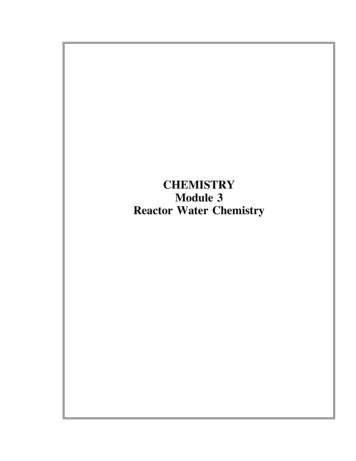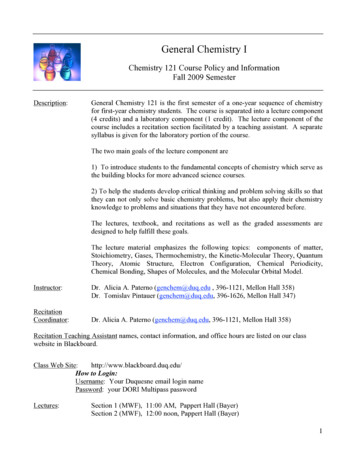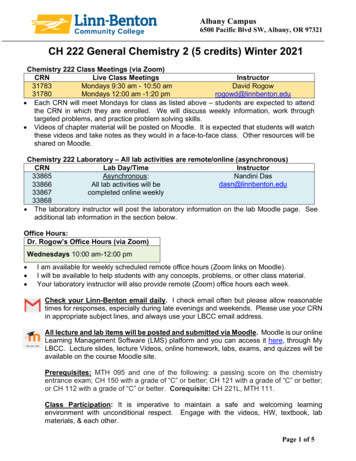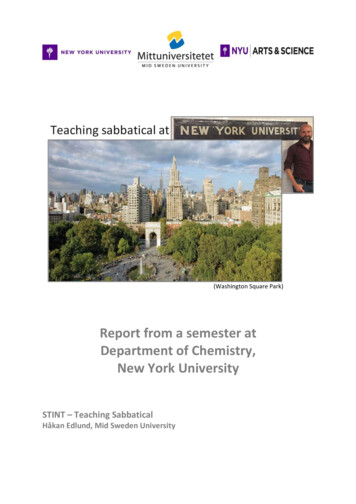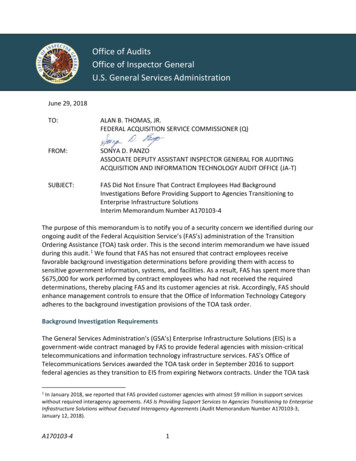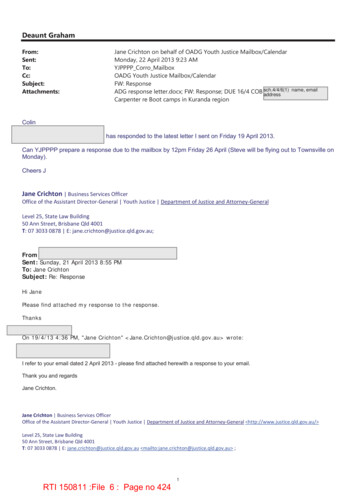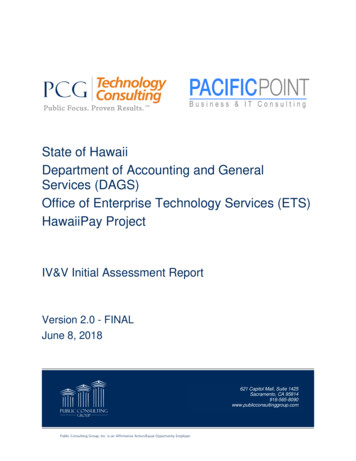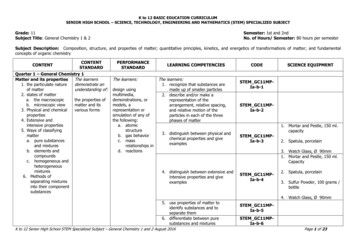
Transcription
K to 12 BASIC EDUCATION CURRICULUMSENIOR HIGH SCHOOL – SCIENCE, TECHNOLOGY, ENGINEERING AND MATHEMATICS (STEM) SPECIALIZED SUBJECTGrade: 11Subject Title: General Chemistry 1 & 2Semester: 1st and 2ndNo. of Hours/ Semester: 80 hours per semesterSubject Description: Composition, structure, and properties of matter; quantitative principles, kinetics, and energetics of transformations of matter; and fundamentalconcepts of organic chemistryCONTENTCONTENTSTANDARDQuarter 1 – General Chemistry 1Matter and its propertiesThe learners1. the particulate naturedemonstrate anof matterunderstanding of:2. states of mattera. the macroscopicthe properties ofb. microscopic viewmatter and its3. Physical and chemicalvarious formsproperties4. Extensive andintensive properties5. Ways of classifyingmattera. pure substancesand mixturesb. elements andcompoundsc. homogeneous andheterogeneousmixtures6. Methods ofseparating mixturesinto their componentsubstancesPERFORMANCESTANDARDThe learners:design usingmultimedia,demonstrations, ormodels, arepresentation orsimulation of any ofthe following:a. atomicstructureb. gas behaviorc. massrelationships ind. reactionsLEARNING COMPETENCIESThe learners:1. recognize that substances aremade up of smaller particles2. describe and/or make arepresentation of thearrangement, relative spacing,and relative motion of theparticles in each of the threephases of matter3. distinguish between physical andchemical properties and giveexamplesCODESCIENCE EQUIPMENTSTEM GC11MPIa-b-1STEM GC11MPIa-b-2STEM GC11MPIa-b-31. Mortar and Pestle, 150 ml.capacity2. Spatula, porcelain3. Watch Glass, Ø 90mm1. Mortar and Pestle, 150 ml.Capacity4. distinguish between extensive andintensive properties and giveexamplesSTEM GC11MPIa-b-42. Spatula, porcelain3. Sulfur Powder, 100 grams /bottle4. Watch Glass, Ø 90mm5. use properties of matter toidentify substances and toseparate them6. differentiate between puresubstances and mixturesK to 12 Senior High School STEM Specialized Subject – General Chemistry 1 and 2 August 2016STEM GC11MPIa-b-5STEM GC11MPIa-b-6Page 1 of 23
K to 12 BASIC EDUCATION CURRICULUMSENIOR HIGH SCHOOL – SCIENCE, TECHNOLOGY, ENGINEERING AND MATHEMATICS (STEM) SPECIALIZED ARNING COMPETENCIESCODE7. differentiate between elementsand compounds8. differentiate betweenhomogenous and heterogenousmixtures9. recognize the formulas ofcommon chemical substancesSTEM GC11MPIa-b-7STEM GC11MPIa-b-8SCIENCE EQUIPMENTLaser Pointer, dual-function,with dry cellsSTEM GC11MPIa-b-91. Evaporating Dish, 75 ml.capacity10. describe separation techniques formixtures and compoundsSTEM GC11MPIa-b-102. Filter Paper, ordinary, 24" x24" sheet3. Glass Funnel, Ø 50mm (TopInside Diameter), length ofstem: 75mmMeasurements1. Accuracy andprecision2. Significant figures incalculations3. Density measurement1. thedifferencebetweenaccuracyandprecision2. differentsources oferrors inmeasurements11. compare consumer products onthe basis of their components foruse, safety, quality and costSTEM GC11MPIa-b-1112. (LAB) apply simple separationtechniques such as distillation,chromatographySTEM GC11MPIa-b-121. differentiate between precision andaccuracySTEM GC11MTIb-131. Condenser, Liebig-type withaccessories2. Distilling Flask, 250ml1. Balance, Triple-Beam, 2610gram capacity2. (LAB) Determine the density ofliquids & solidsK to 12 Senior High School STEM Specialized Subject – General Chemistry 1 and 2 August 2016STEM GC11MTIb-142. Graduated cylinder, 10 mlcapacity3. Graduated cylinder, 100 ml.capacityPage 2 of 23
K to 12 BASIC EDUCATION CURRICULUMSENIOR HIGH SCHOOL – SCIENCE, TECHNOLOGY, ENGINEERING AND MATHEMATICS (STEM) SPECIALIZED ARNING COMPETENCIESCODESCIENCE EQUIPMENT4. Hydrometer for heavyliquids5. Hydrometer for light liquidsAtoms, Molecules, andIons1. Dalton’s atomictheory2. Basic laws of matter3. Atomic structure4. Subatomic particles(protons, electrons,neutrons)5. Molecules and Ions6. Chemical Formulas7. Naming Compounds1. atomicstructure2. formulasand namesofcompounds1. explain how the basic laws ofmatter (law of conservation ofmass, law of constant composition,law of multiple proportion) led tothe formulation of Dalton’s AtomicTheorySTEM GC11AMIc-e-152. describe Dalton’s Atomic TheorySTEM GC11AMIc-e-163. differentiate among atomicnumber, mass number, andisotopes, and which of thesedistinguishes one element fromanotherSTEM GC11AMIc-e-174. write isotopic symbolsSTEM GC11AMIc-e-185. recognize common isotopes andtheir uses.STEM GC11AMIc-e-191. Boric Acid, 100 grams /bottle6. differentiate among atoms,molecules, ions and give examplesK to 12 Senior High School STEM Specialized Subject – General Chemistry 1 and 2 August 2016STEM GC11AMIc-e-202. Calcium Chloride, 100 grams/ bottle3. Copper Sulfate, CuSO4, 100grams / bottle4. Potassium Chloride, 100grams / bottlePage 3 of 23
K to 12 BASIC EDUCATION CURRICULUMSENIOR HIGH SCHOOL – SCIENCE, TECHNOLOGY, ENGINEERING AND MATHEMATICS (STEM) SPECIALIZED ARNING COMPETENCIES7. represent compounds usingchemical formulas, structuralformulas and modelsSTEM GC11AMIc-e-218. give the similarities and differencesbetween the empirical formula andmolecular formula of a compoundSTEM GC11AMIc-e-229. name compounds given theirformula and write formula giventhe name of the compoundSTEM GC11AMIc-e-2310. (LAB) Practice chemicalnomenclature: writing the chemicalformulas of ionic compounds;naming ionic compounds fromformulasStoichiometry1. Atomic mass2. Avogadro’s number3. The mole concept1. the moleconcept inrelation toAvogadro’snumber andmassCODESTEM GC11AMIc-e-241. explain relative atomic mass andaverage atomic massSTEM GC11S-Ie252. define a moleSTEM GC11S-Ie263. illustrate Avogadro’s number withexamplesSTEM GC11S-Ie274. determine the molar mass ofelements and compoundsSTEM GC11S-Ie285. calculate the mass of a givennumber of moles of an element orcompound or vice versaSTEM GC11S-Ie296. calculate the mass of a givennumber of particles of an elementor compound or vice versaSTEM GC11S-Ie30K to 12 Senior High School STEM Specialized Subject – General Chemistry 1 and 2 August 2016SCIENCE EQUIPMENTPage 4 of 23
K to 12 BASIC EDUCATION CURRICULUMSENIOR HIGH SCHOOL – SCIENCE, TECHNOLOGY, ENGINEERING AND MATHEMATICS (STEM) SPECIALIZED SUBJECTCONTENT4. Percent compositionand chemical formulas5. Chemical reactions andchemical equations6. Types of chemicalreactions in aqueoussolutionsCONTENTSTANDARD2. therelationshipof percentcompositionand chemicalformula3. the use ofchemicalformulas RNING COMPETENCIESCODE1. calculate the percent compositionof a compound from its formulaSTEM GC11PCIf-312. calculate the empirical formulafrom the percent composition of acompoundSTEM GC11PCIf-323. calculate molecular formula givenmolar massSTEM GC11PCIf-334. write equations for chemicalreactions and balance theequationsSTEM GC11CRIf-g-345. interpret the meaning of abalanced chemical reaction interms of the law of conservation ofmassSCIENCE EQUIPMENTSTEM GC11CRIf-g-351. Alcohol Burner, glass,150ml. capacity2. Alcohol Thermometer, -20ºCto 110ºC6. describe evidences that a chemicalreaction has occurredSTEM GC11CRIf-g-363. Beaker, 100 ml, borosilicate4. Beaker, 250 ml, borosilicate5. Beaker, 50 ml, borosilicate6. Beaker, 500 ml, borosilicate7. Bunsen Burner, gas-typeK to 12 Senior High School STEM Specialized Subject – General Chemistry 1 and 2 August 2016Page 5 of 23
K to 12 BASIC EDUCATION CURRICULUMSENIOR HIGH SCHOOL – SCIENCE, TECHNOLOGY, ENGINEERING AND MATHEMATICS (STEM) SPECIALIZED ARNING COMPETENCIESCODESCIENCE EQUIPMENT8. Ferrous Sulfate,100 grams /bottle9. LPG tank with gas, 11 kg.capacity, regulator & hoseassembly10. Magnesium Ribbon,minimum of 1 meter/roll11. Potassium Iodide, KI, 100grams / bottle12. Reagent Bottle, narrowmouth amber color (250ml.Capacity)13. Reagent Bottle, wide mouthcolorless (250ml. Cap.)14. Stirring Rod, Ø 6mm x250mm long15. Sodium sulfate, 100 grams /bottle16. Sulfuric Acid, 500 ml / bottle17. Test Tube, Ø16mm x150mm long, borosilicate18. Vials, screw neck vial withcover, 25mL19. Vials, screw neck vial withK to 12 Senior High School STEM Specialized Subject – General Chemistry 1 and 2 August 2016Page 6 of 23
K to 12 BASIC EDUCATION CURRICULUMSENIOR HIGH SCHOOL – SCIENCE, TECHNOLOGY, ENGINEERING AND MATHEMATICS (STEM) SPECIALIZED ARNING COMPETENCIESCODESCIENCE EQUIPMENTcover, 50mL20. Zinc Chloride, ZnCl2, 100grams / bottle21. Zinc Pellets, 100 grams /bottle7. Mass relationships inchemical reactionsGases1. Pressure of a gasa. Units of pressure2. The Gas lawsa. Boyle’s Lawb. Charles’ Lawc. Avogadro’s Law3. Ideal Gas Equation4. thequantitativerelationshipof reactantsand productsin a chemicalreaction5. themathematicalrelationshipbetweenpressure,volume, andtemperatureof a gas7. (LAB) Perform exercises onwriting and balancing chemicalequations1. construct mole or mass ratios fora reaction in order to calculate theamount of reactant needed oramount of product formed in termsof moles or mass2. Calculate percent yield andtheoretical yield of the reaction3. explain the concept of limitingreagent in a chemical reaction;identify the excess reagent(s)4. calculate reaction yield when alimiting reagent is present5. (LAB) Determine massrelationship in a chemical reaction1. define pressure and give thecommon units of pressure2. express the gas laws in equationform3. use the gas laws to determinepressure, volume, or temperatureof a gas under certain conditionsof change4. use the ideal gas equation tocalculate pressure, volume,K to 12 Senior High School STEM Specialized Subject – General Chemistry 1 and 2 August 2016STEM GC11CRIf-g-37STEM GC11MRIg-h-38STEM GC11MRIg-h-39STEM GC11MRIg-h-40STEM GC11MRIg-h-41STEM GC11MRIg-h-42STEM GC11G-Ihi-43STEM GC11G-Ihi-44STEM GC11G-Ihi-45Open U-tube Manometer (andAccessories)STEM GC11G-Ihi-46Page 7 of 23
K to 12 BASIC EDUCATION CURRICULUMSENIOR HIGH SCHOOL – SCIENCE, TECHNOLOGY, ENGINEERING AND MATHEMATICS (STEM) SPECIALIZED SUBJECTCONTENT4. Dalton’s Law of partialpressures5. Gas stoichiometry6. Kinetic molecular theoryof gasesCONTENTSTANDARDPERFORMANCESTANDARDLEARNING COMPETENCIEStemperature, or number of molesof a gas5. use Dalton’s law of partialpressures to relate mole fractionand partial pressure of gases in amixture6. the partialpressures ofgases in amixture7. quantitativerelationshipsof reactantsand productsin a gaseousreaction6. apply the principles ofstoichiometry to determine theamounts (volume, number ofmoles, or mass) of gaseousreactants and products8. the behaviorandproperties ofgases at themolecularlevelCODESCIENCE EQUIPMENTSTEM GC11DLIi-47STEM GC11GSIi-j-487. explain the gas laws in terms ofthe kinetic molecular theory ofgasesSTEM GC11KMTIj-498. relate the rate of gas effusion withmolar massSTEM GC11KMTIj-509. (LAB) Demonstrate Graham’s lawof effusion in an experimentSTEM GC11KMTIj-511. describe the quantum mechanicalmodel of the atom2. describe the electronic structure ofatoms in terms of main energylevels, sublevels, and orbitals, andrelate this to energy3. use quantum numbers to describean electron in an atom4. (LAB) Perform exercises onquantum numbers5. write the electronic configurationof atomsSTEM GC11ESIIa-b-52Quarter 2 – General Chemistry 1Electronic Structure ofAtoms1. Quantum mechanicaldescription of the atom2. Schrodinger’s model ofthe hydrogen atom andwave functions3. Main energy levels,sublevels and orbitals4. Quantum numbers5. Electron Configurationa. Aufbau Principlethe quantummechanicaldescription of theatom and itselectronicstructureillustrate thereactions at themolecular level in anyof the following:1. enzyme action2. proteindenaturation3. separation ofcomponents incoconut milkK to 12 Senior High School STEM Specialized Subject – General Chemistry 1 and 2 August 2016STEM GC11ESIIa-b-53STEM GC11ESIIa-b-54STEM GC11ESIIa-b-55STEM GC11ESIIa-b-56Page 8 of 23
K to 12 BASIC EDUCATION CURRICULUMSENIOR HIGH SCHOOL – SCIENCE, TECHNOLOGY, ENGINEERING AND MATHEMATICS (STEM) SPECIALIZED SUBJECTCONTENTCONTENTSTANDARDb. Pauli ExclusionPrinciplec. Hund’s Ruled. Diamagnetism andParamagnetisme. Orbital diagramsElectronic Structure andPeriodicity1. The ElectronConfiguration and thePeriodic Table2. Periodic Variation inAtomic Propertiesa. Atomic Radius andeffective nuclearcharge; the shieldingeffect in manyelectron atomsb. Ionic radiusc. Ionization energyd. Electron affinityChemical BondingIonic Bonds1. The stability of noblegasesthe arrangementof elements inthe periodic tableand trends in theproperties of theelements in termsof electronicstructure1. ionic bondformation interms ofatomicPERFORMANCESTANDARDLEARNING COMPETENCIES6. determine the magnetic propertyof the atom based on its electronicconfiguration7. draw an orbital diagram torepresent the electronicconfiguration of atoms8. (LAB) Perform exercises onwriting electronic configuration1. explain the periodic recurrence ofsimilar properties among elementsin the periodic table in terms ofelectronic structure2. relate the number of valenceelectrons of elements to theirgroup number in the periodic table3. compare the properties of familiesof elements4. predict the properties of individualelements based on their position inthe periodic table5. describe and explain the trends inatomic properties in the periodictable6. (LAB) Investigate reactions of ionsand apply these in qualitativeanalysis7. (LAB) Determine periodicproperties of the main groupelements1. relate the stability of noble gasesto their electron configuration2. state the octet ruleK to 12 Senior High School STEM Specialized Subject – General Chemistry 1 and 2 August 2016CODESCIENCE EQUIPMENTSTEM GC11ESIIa-b-57STEM GC11ESIIa-b-58STEM GC11ESIIa-b-59STEM GC11ESPIIc-d-60STEM GC11ESPIIc-d-61STEM GC11ESPIIc-d-62STEM GC11ESPIIc-d-63STEM GC11ESPIIc-d-64STEM GC11ESPIIc-d-65STEM GC11ESPIIc-d-66STEM GC11CBIId-g-67STEM GC11CBIId-g-68Page 9 of 23
K to 12 BASIC EDUCATION CURRICULUMSENIOR HIGH SCHOOL – SCIENCE, TECHNOLOGY, ENGINEERING AND MATHEMATICS (STEM) SPECIALIZED SUBJECTCONTENT2.3.4.5.6.7.Forming ionsIonic bondingIonic compoundsFormulasStructurePropertiesCovalent Bonds1. Formation of covalentbonds2. Formulas of molecularcompounds3. Lewis structure ofmolecules4. Molecules of elements5. Molecules of compounds6. Structure and propertiesof molecular compoundsCONTENTSTANDARDproperties2. the propertiesof ioniccompounds inrelation totheir structure1. covalent bondformation interms ofatomicproperties2. the propertiesof molecularcovalentcompounds inrelation totheirPERFORMANCESTANDARDLEARNING COMPETENCIESCODE3. determine the charge of the ionsformed by the representativeelements and relate this to theirionization energy or electronaffinity, valence electronconfiguration and position in theperiodic tableSTEM GC11CBIId-g-694. draw the Lewis structure of ionsSTEM GC11CBIId-g-705. predict the formula of the ioniccompound formed by a metal andnon-metal among therepresentative elementsSTEM GC11CBIId-g-716. Lewis structure of ionic compoundsSTEM GC11CBIId-g-727. list the properties of ioniccompounds and explain theseproperties in terms of theirstructure8. (LAB) Perform exercises onwriting Lewis structures ofions/ionic compounds andmolecules9. describe covalent bonding in termsof electron sharing10. apply the octet rule in theformation of molecular covalentcompounds11. write the formula of molecularcompounds formed by thenonmetallic elements of therepresentative block12. draw Lewis structure of molecularcovalent compoundsK to 12 Senior High School STEM Specialized Subject – General Chemistry 1 and 2 August 2016SCIENCE EQUIPMENTSTEM GC11CBIId-g-73STEM GC11CBIId-g-74STEM GC11CBIId-g-75STEM GC11CBIId-g-76STEM GC11CBIId-g-77STEM GC11CBIId-g-78Page 10 of 23
K to 12 BASIC EDUCATION CURRICULUMSENIOR HIGH SCHOOL – SCIENCE, TECHNOLOGY, ENGINEERING AND MATHEMATICS (STEM) SPECIALIZED SUBJECTCONTENT7. Strength of covalentbonds8. Electronegativity andbond polarity9. Geometry of molecules10. Polarity of compoundsOrganic compounds1. The carbon atom2. Bonding patterns inhydrocarbons3. Properties andreactivities of commonfunctional groups4. Polymers5. BiomoleculesCONTENTSTANDARDstructurethe properties oforganiccompounds andpolymers in termsof their structurePERFORMANCESTANDARDLEARNING COMPETENCIES13. explain the properties of covalentmolecular compounds in terms oftheir structure.14. determine the polarity of a bondbased on the electronegativities ofthe atoms forming the bond15. describe the geometry of simplecompounds16. determine the polarity of simplemolecules17. (LAB) Determine and/or observeevidence of molecular polarity1.describe the special nature ofcarbon2.3.4.5.6.7.list general characteristics oforganic compoundsdescribe the bonding in ethane,ethene(ethylene) andethyne(acetylene) and explaintheir geometry in terms ofhybridization and σ and ¶carbon-carbon bondsdescribe the different functionalgroupscite uses of representativeexamples of compoundsbearing the different functionalgroupsdescribe structural isomerism;give examplesdescribe some simple reactionsof organic compounds:combustion of organic fuels,addition, condensation, andK to 12 Senior High School STEM Specialized Subject – General Chemistry 1 and 2 August 2016CODESCIENCE EQUIPMENTSTEM GC11CBIId-g-79STEM GC11CBIId-g-80STEM GC11CBIId-g-81STEM GC11CBIId-g-82STEM GC11CBIId-g-83STEM GC11OCIIg-j-84STEM GC11OCIIg-j-85STEM GC11OCIIg-j-86STEM GC11OCIIg-j-87STEM GC11OCIIg-j-88STEM GC11OCIIg-j-89STEM GC11OCIIg-j-90Page 11 of 23
K to 12 BASIC EDUCATION CURRICULUMSENIOR HIGH SCHOOL – SCIENCE, TECHNOLOGY, ENGINEERING AND MATHEMATICS (STEM) SPECIALIZED ARNING COMPETENCIESCODESCIENCE EQUIPMENTsaponification of fats8.describe the formation andstructure of polymersSTEM GC11OCIIg-j-919.give examples of polymersSTEM GC11OCIIg-j-9210.11.12.13.14.15.Third Quarter – General Chemistry 2Intermolecular Forces1. the propertiesand Liquids and Solidsof liquids and1. Kinetic molecularsolids to themodel of liquids andnature ofsolidsforcesdesign a simpleinvestigation todetermine the effecton boiling point orfreezing point when aexplain the properties of somepolymers in terms of theirstructuredescribe some biomolecules:proteins, nucleic acids, lipids,and carbohydratesdescribe the structure ofproteins, nucleic acids, lipids,and carbohydrates, and relatethem to their function(LAB) Perform exercises on thestructure of organic compoundsusing of models(LAB) Prepare selected organiccompound and describe theirproperties(LAB) Perform laboratoryactivities on enzyme action,protein denaturation,separation of components incoconut milkSTEM GC11OCIIg-j-93STEM GC11OCIIg-j-94STEM GC11OCIIg-j-95STEM GC11OCIIg-j-96STEM GC11OCIIg-j-97STEM GC11OCIIg-j-981.use the kinetic molecular modelto explain properties of liquidsand solidsSTEM GC11IMFIIIa-c-992.describe and differentiate thetypes of intermolecular forcesSTEM GC11IMFIIIa-c-100K to 12 Senior High School STEM Specialized Subject – General Chemistry 1 and 2 August 2016Laser Pointer, dual-function,with dry cellsPage 12 of 23
K to 12 BASIC EDUCATION CURRICULUMSENIOR HIGH SCHOOL – SCIENCE, TECHNOLOGY, ENGINEERING AND MATHEMATICS (STEM) SPECIALIZED .-Intermolecular ForcesDipole-dipole forcesIon-dipole forcesDispersion forcesHydrogen bondsProperties of liquidsand IMFSurface TensionViscosityVapour pressure,boiling pointMolar heat ofvaporizationStructure andProperties of WaterTypes and propertiesof solidsCrystalline andamorphous solidsTypes of Crystals –ionic, covalent,molecular, metallicPhase Changesphase diagrams ofwater and carbondioxideCONTENTSTANDARDbetweenparticles2. phase changesin terms of theaccompanyingchanges inenergy andforcesbetweenparticlesPERFORMANCESTANDARDsolid is dissolved inwaterLEARNING COMPETENCIES3.predict the intermolecularforces possible for a molecule4.describe the followingproperties of liquids, andexplain the effect ofintermolecular forces on theseproperties: surface tension,viscosity, vapor pressure,boiling point, and molar heat ofvaporizationexplain the properties of waterwith its molecular structure andintermolecular forcesdescribe the difference instructure of crystalline andamorphous solidsdescribe the different types ofcrystals and their properties:ionic, covalent, molecular, andmetallic.describe the nature of thefollowing phase changes interms of energy change and theincrease or decrease inmolecular order: solid-liquid,liquid-vapor, and solid-vapor5.6.7.8.9.10.CODESTEM GC11IMFIIIa-c-101STEM GC11IMFIIIa-c-102STEM GC11IMFIIIa-c-103STEM GC11IMFIIIa-c-104STEM GC11IMFIIIa-c-105STEM GC11IMFIIIa-c-106interpret the phase diagram ofwater and carbon dioxideSTEM GC11IMFIIIa-c-107(LAB) Measure and explainthe difference in the viscosity ofsome liquidsSTEM GC11IMFIIIa-c-108K to 12 Senior High School STEM Specialized Subject – General Chemistry 1 and 2 August 2016SCIENCE EQUIPMENTPage 13 of 23
K to 12 BASIC EDUCATION CURRICULUMSENIOR HIGH SCHOOL – SCIENCE, TECHNOLOGY, ENGINEERING AND MATHEMATICS (STEM) SPECIALIZED SUBJECTCONTENTPhysical Properties ofSolutions1. Types of Solutions2. Energy of solutionformation3. Concentration Unitsand comparison ofconcentration unitsa. percent by mass, byvolumeb. mole fractionc. molalityd. molaritye. percent by volume,percent by mass,ppm4. Solution stoichiometry5. Factors affectingSolubility6. Colligative Propertiesof Nonelectrolyte andelectrolyte solutionsCONTENTSTANDARDproperties ofsolutions,solubility, and thestoichiometry ofreactions insolutionsPERFORMANCESTANDARDLEARNING COMPETENCIESCODE11.(LAB) Determine and explainthe heating and cooling curveof a substanceSTEM GC11IMFIIIa-c-1091.describe the different types ofsolutionsSTEM GC11PPIIId-f-1102.use different ways ofexpressing concentration ofsolutions: percent by mass,mole fraction, molarity,molality, percent by volume,percent by mass, ppmperform stoichiometriccalculations for reactions insolutionexplain the effect oftemperature on the solubility ofa solid and of a gas3.4.5.explain the effect of pressureon the solubility of a gas6.describe the effect ofconcentration on the colligativeproperties of solutionsdifferentiate the colligativeproperties of nonelectrolytesolutions and of electrolytesolutionsCalculate boiling point elevationand freezing point depressionfrom the concentration of asolute in a solution7.8.9.calculate molar mass fromcolligative property dataK to 12 Senior High School STEM Specialized Subject – General Chemistry 1 and 2 August 2016SCIENCE EQUIPMENTElectrical ConductivityApparatusSTEM GC11PPIIId-f-111STEM GC11PPIIId-f-112STEM GC11PPIIId-f-113STEM GC11PPIIId-f-114STEM GC11PPIIId-f-115Osmosis ApparatusSTEM GC11PPIIId-f-116Ammonium Chloride, 100 grams/ bottleSTEM GC11PPIIId-f-117STEM GC11PPIIId-f-118Page 14 of 23
K to 12 BASIC EDUCATION CURRICULUMSENIOR HIGH SCHOOL – SCIENCE, TECHNOLOGY, ENGINEERING AND MATHEMATICS (STEM) SPECIALIZED ARNING COMPETENCIESCODESCIENCE EQUIPMENT1. Burette, 25ml. Capacity(acid)2. Burette, 25ml. Capacity(base)3. Erlenmeyer Flask, 250 ml.,borosilicate10.(LAB) Perform acid-basetitration to determineconcentration of solutionsSTEM GC11PPIIId-f-1194. Graduated Pipette, 10ml.Cap. with rubber pipettor5. Lye (NaOH), odorless whitesemi-transparent solids, 250grams / bottle6. Phenolphthalein Indicator,100 grams/bottle7. Volumetric Flask, 250ml.11.12.Thermochemistry1. Energy Changes inChemical Reactions:exothermic andendothermic processes2. First Law ofThermodynamicsenergy changesin chemicalreactions1.(LAB) Determine the solubilityof a solid in a given amount ofwater at different temperatures(LAB) Determine the molarmass of a solid from the changeof melting point or boiling pointof a solutionexplain the energy changesduring chemical reactionsSTEM GC11PPIIId-f-120STEM GC11PPIIId-f-121STEM GC11TCIIIg-i-1221. Calorimeter2.distinguish between exothermicand endothermic processesK to 12 Senior High School STEM Specialized Subject – General Chemistry 1 and 2 August 2016STEM GC11TCIIIg-i-1232. Lye (NaOH), odorless whitesemi-transparent solids, 250grams / bottlePage 15 of 23
K to 12 BASIC EDUCATION CURRICULUMSENIOR HIGH SCHOOL – SCIENCE, TECHNOLOGY, ENGINEERING AND MATHEMATICS (STEM) SPECIALIZED SUBJECTCONTENT3.4.5.CONTENTSTANDARDEnthalpy of a ChemicalReaction- thermochemicalequationsCalorimetryStandard Enthalpy ofFormation and ReactionHess’ LawPERFORMANCESTANDARDLEARNING COMPETENCIES3.explain the first law ofthermodynamics4.explain enthalpy of a reaction.5.Write the thermochemicalequation for a chemical reactionCalculate the change inenthalpy of a given reactionusing Hess Law(LAB) Do exercises onthermochemical calculations6.7.CODESCIENCE EQUIPMENTSTEM GC11TCIIIg-i-124STEM GC11TCIIIg-i-125STEM GC11TCIIIg-i-126STEM GC11TCIIIg-i-127STEM GC11TCIIIg-i-1281. Calorimeter8.(LAB)Determine the heat ofneutralization of an acidSTEM GC11TCIIIg-i-1292. Hydrochloric Acid, HCl,technical grade, 500 ml /bottle3. Lye (NaOH), odorless whitesemi-transparent solids, 250grams / bottleChemical Kinetics1. The Rate of a Reaction2. Factors that influencereaction rate3. The Rate Law and itscomponents4. Collision theory5. Catalysis1. The rate of areaction andthe variousfactors thatinfluence it2. the collisiontheory1.2.3.4.5.6.describe how various factorsinfluence the rate of a reactionwrite the mathematicalrelationship between the rate ofa reaction, rate constant, andconcentration of the reactantsdifferentiate zero, first-, andsecond-order reactionswrite the rate law for first-orderreactiondiscuss the effect of reactantconcentration on the half-timeof a first-order reactionexplain the effect oftemperature on the rate of aK to 12 Senior High School STEM Specialized Subject – General Chemistry 1 and 2 August 2016STEM GC11CKIIIi-j-130STEM GC11CKIIIi-j-131STEM GC11CKIIIi-j-132STEM GC11CKIIIi-j-133STEM GC11CKIIIi-j-134STEM GC11CKIIIi-j-1351. Alcohol Burner, glass,150ml. capacityPage 16 of 23
K to 12 BASIC EDUCATION CURRICULUMSENIOR HIGH SCHOOL – SCIENCE, TECHNOLOGY, ENGINEERING AND MATHEMATICS (STEM) SPECIALIZED ARNING COMPETENCIESCODESCIENCE EQUIPMENTreaction2. Bunsen Burner, gas-type3. LPG tank with gas, 11 kg.capacity, regulator & hoseassembly7.8.9.10.Fourth Quarter – General Chemistry 2ChemicalspontaneousThermodynamicschange, entropy,1. Spontaneous processes and free energy2. Entropy3. The Second Law ofThermodynamics4. Gibbs Free Energy andChemical EquilibriumChemical Equilibrium1. The equilibriumChemicalequilibrium andprepare a poster on aspecific application ofone of the following:a. Acid-baseequilibriumb. ElectrochemistryInclude in the posterthe concepts,principles, andchemical reactionsinvolved, anddiagrams ofprocesses and otherrelevant materialsexplain reactions qualitatively interms of molecular collisionsexplain activation energy andhow a catalyst affects thereaction ratecite and differentiate the typesof catalysts(LAB)Determine the effect ofvarious factors on the rate of areaction1. predict the spontaneity of aprocess based on entropy2. determine whether entropyincreases or decreases if thefollowing are changed:temperature, phase, number ofparticles3. explain the second law ofthermodynamics and itssignificance4. use Gibbs’ free energy todetermine the direction of areaction1. describe reversible reactionsK to 12 Senior High School STEM Specialized Subject – General Chemistry 1 and 2 August 2016STEM GC11CKIIIi-j-136STEM GC11CKIIIi-j-137Manganese Dioxide, 50 grams /bottleSTEM GC11CKIIIi-j-138STEM GC11CKIIIi-j-139STEM GC11CTIVa-b-140STEM GC11CTIVa-b-141STEM GC11CTIVa-b-142STEM GC11CTIVa-b-143STEM GC11CEIVb-e-144Page 17 of 23
K to 12 BASIC EDUCATION CURRICULUMSENIOR HIGH SCHOOL – SCIENCE, TECHNOLOGY, ENGINEERING AND MATHEMATICS (STEM) SPECIALIZED SUBJECTCONTENTcondition2. Writing the reactionquotient/equilibriumconstant expression3. Predicting the directionof a reaction4. Significance of theequilibrium constant5. Le Chatelier’s PrincipleCONTENTSTANDARDLe Chatelier’sPrinciplePERFORMANCESTANDARDLEARNING COMPETENCIES2. explain chemical equilibrium interms of the reaction rates of theforward and the reverse reactionSTEM GC11CEIVb-e-1453. write expressions for the reactionquotient/equilibrium constantsSTEM GC11CEIVb-e-1464. explain the significance of thevalue of the equilibrium constant.STEM GC11CEIVb-e-1475. calculate equilibrium constant andthe pressure or concentration ofreactants or products in anequilibrium mixture6. state the Le Chatelier’s principleand apply it qualitatively todescribe the effect of changes inpressure, concentration andtemperature on a system atequilibrium7. (LAB) Describe the behavior ofreversible reactions8. (LAB) Describe the behavior of areaction mixture when thefollowing takes place:a. change in concentration ofreactants or productsb. change in temperature9. (LAB) Perform calculationsinvolving equilibrium of gaseousreactionsAcid-Base Equilibria andSalt Equilibria1. Bronsted acids andbases1. acid-baseequilibriumand itsapplicationsCODE1. define Bronsted acids and bases2. discuss the acid-base property ofwaterK to 12 Senior High School STEM Specialized Subject – General Chemistry 1 and 2 August 2016SCIENCE EQUIPMENTSTEM GC11CEIVb-e-148STEM GC11CEIVb-e-149STEM GC11CEIVb-e-150STEM GC11CEIVb-e-151STEM GC11CEIVb-e-152STEM GC11ABIVf-g-153STEM GC11ABIVf-g-154Page 18 of 23
K to 12 BASIC EDUCATION CURRICULUMSENIOR HIGH SCHOOL – SCIENCE, TECHNOLOGY, ENGINEERING AND MATHEMATICS (STEM) SPECIALIZED SUBJECTCONTENT2. The acid-base propertiesof water3. pH- a measure of acidity4. Strength of acids andbases5. Weak acids/weak basesand ionization constants6. Relationship betweenthe ionization constantsof acids and
K to 12 BASIC EDUCATION CURRICULUM SENIOR HIGH SCHOOL – SCIENCE, TECHNOLOGY, ENGINEERING AND MATHEMATICS (STEM) SPECIALIZED SUBJECT K to 12 Senior High School STEM Specialized Subject – General Chemistry 1 and 2 August 2016 Page 1 of 23 Grade: 11 Semester: 1st and 2nd Subject Tit


